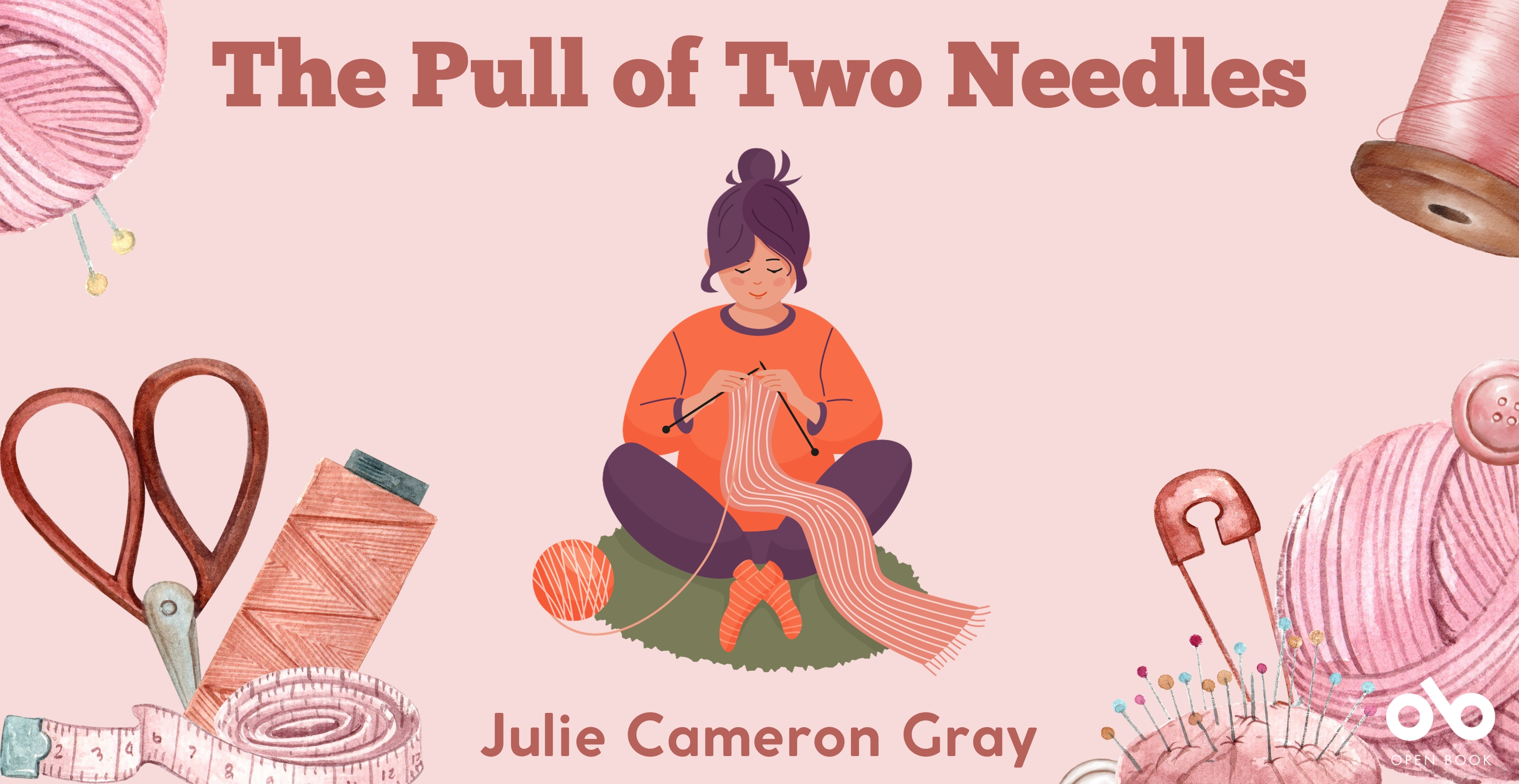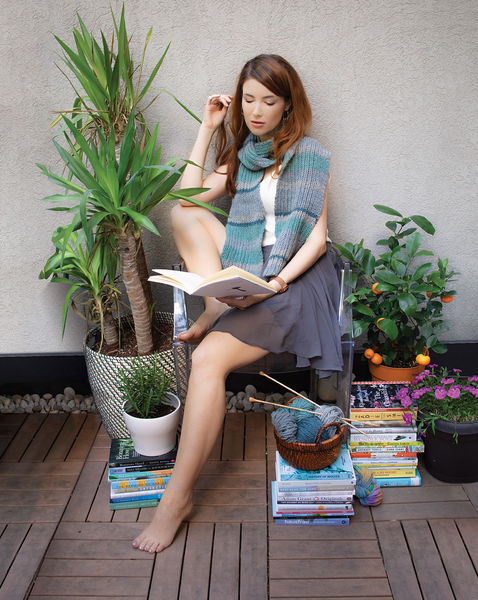The Pull of Two Needles
By Julie Cameron Gray
My first version of this essay was about how my two obsessions, knitting and writing, don’t compete with each other. I wrote at length about how they spin together in my brain in complicated steps, creating new ideas for writing and shapes for new garments. And like anything creative, the more I get the ideas out onto paper or in yarn, the more ideas come.
But actually, that isn’t true for me at all. They are competing forces, twin passions that pull in different directions most of the time. Writing is my got-to-work-at-it marriage; knitting is my sweater-wearing sidepiece. When I receive a rejection from a round of poems I’ve sent out, Writing tells me to review, revise, and try again. Necessary, but cold comfort in comparison to Knitting, who tells me everything is going to be okay, how about a bit of knitting to soften the blow, while a mohair and silk sweater grows between my hands.
I know that with enough time, I’ll knit something that I can wear and enjoy, and if not, I can unravel it and knit something else, getting it right the next time. It never takes more than two tries with my knitting. But with writing I have no such guarantees- If I get it wrong the first time, I could still get it just as wrong the second, third, fourth time. There are no guarantees that when I sit down to write, II’ll craft something that I love. And even when I’ve written something I love, there’s no guarantee it’ll find a reader who feels the same as me.
Which isn’t to say that they don’t compliment each other in some ways - I will often watch writing-as-craft talks or readings online while knitting, or listen to audiobooks or podcasts, pausing to take notes or pausing altogether to write something if it jolts a bolt of clarity into me. But it is comfort, a sort of dance between them.
I wonder if I would have published more by now if I spent as much time on my writing as I have on my knitting. It’s a tantalizing thought, one that I use to flog myself with when I shy away from Facebook because it feels like every writer I know is trumpeting their latest publication, teaching job, residency, accolades. My Facebook is a string of "aw shucks I’m so grateful to have another new book coming out" posts. They definitely worked for it and I’m happy for them – only after I wince in shame first. Maybe that could have been me, if I wasn’t so tangled up in yarn. Maybe, I chastise myself, maybe if I spent as much time writing as I did knitting, I’d have a shelf- full of published books, spines lined up and shining.
I’m not great at self-acceptance or self-love, as you can probably tell. Which explains why some years I send out only one or two submissions, and then retreat to the woolly comfort of my knitting world.
The funny thing is, knitters are notoriously avid readers. Talking about books with knitters is hugely rewarding, their Instagram accounts full of book recommendations and cover shots, artfully posed next to their current knit in progress. I do it too, on my knitting Instagram account, which is separate from my writer Instagram account. Guess which one has (thousands) more followers.
That’s the thing- it’s so much easier to keep going with the thing that provides the reward, the likes, the dopamine hit of acceptance while internet well-wishers cheer for you. It’s so much easier to do just about anything other than writing. Except I can’t fathom going on with my life without writing. I truly can’t. While writing is bloody hard for me, and the rewards are few and far between, it is so encoded into who I am as a person, into the way my mind works, the way I look at the world. If I never knitted again, I’d miss it but I would be fine. If I never wrote again, I would feel like I had failed at my entire reason for existing.
Knitting is like speaking another language - you can freestyle all you want when you are fluent. I design knitting patterns now with ease, explain technical details in a language that is not dissimilar to computer programming languages. The mathematics that underpins them - a beautiful, radiant logic. Come to think of it, it reminds me a lot of the structure of poetic forms, the sestina, the pantoum. Pattern languages have a beauty that transcend genre.
Writing, I often find myself sneaking up on it. Sit down and see what happens, often not even reading it over. My ‘working’ documents are a tangled mess, pages and pages of random scribbles on hazy subjects- two different novel ideas, an entire themed poetry collection, a couple of short stories that are perpetually in progress, an essay or two on whatever is scratching at a corner of my brain that doesn’t fit into any of the above. But sometimes as I read through my notes, poems or story ideas suddenly appear in those words, like deer stepping into a clearing. And I write as fast as I can then, trying to get the idea down as close as possible to that moment, what it felt like when I saw the poem or story come into view.
Your CanLit News
Subscribe to Open Book’s newsletter to get local book events, literary content, writing tips, and more in your inbox
And when that happens, I feel like maybe everything I’m doing, even the knitting, is exactly what I need to be doing.
The views expressed by Open Book columnists are those held by the authors and do not necessarily reflect the views of Open Book.
Julie Cameron Gray is originally from Sudbury, Ontario. She is the author of two poetry collections - Lady Crawford (Palimpsest Press), Tangle (Tightrope Books), and is nearing completion on her 3rd poetry manuscript. She has previously published in Vallum, Ex-Puritan, The Fiddlehead, EVENT, Prairie Fire, Carousel, and Best Canadian Poetry. Lady Crawford was shortlisted for the Pat Lowther Award.





